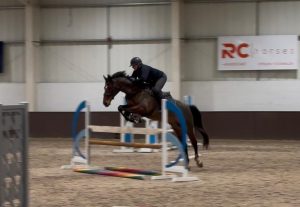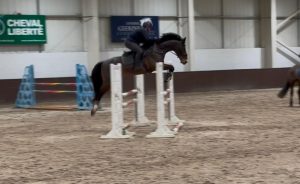Report from the Richard Waygood MBE Jumping Training at the Annual Course
 It felt a real privilege to sit at Addington, watching a World Class jump trainer teaching / coaching a wide range of F&I horses and riders. Dickie was so generous in sharing his knowledge with our wide range of partnerships. The two days were a masterclass of excellent coaching skills.
It felt a real privilege to sit at Addington, watching a World Class jump trainer teaching / coaching a wide range of F&I horses and riders. Dickie was so generous in sharing his knowledge with our wide range of partnerships. The two days were a masterclass of excellent coaching skills.
There are always lots of different reasons riders put themselves in front of their friends and colleagues – and right from the start, Dickie gave us his thoughts on his Coaching strategies for them;
Instructor – quite often / when needed / direct help with learning
Instructor / Coach – to help the rider start to take ownership / develop their own way
Coach / Mentor – set exercises / ensure rider is taking responsibility / keep on right path
Partnership – For the more elite riders, who are confident with their own way and have good experience, timing and feel. They benefit from conversations and discussions to tweak and refine their training, and will often “lead” the sessions.
The first day was spent developing balance and rhythm using exercises over poles and smaller fences. A standard 5 stride distance over “cavalletti” (first planks then small fences) was used to calibrate the forward canter needed for the modern event horse/jumper. Riders were encouraged to take responsibility for the horse’s balance every step of the accurate line to be ridden. Rideability was talked about, tested and developed – so that the often-repeated phrase of “Balance and Impulsion give you Options” was clearly understood as the horses started to give the riders the feel of the 9 miles an hour/12 miles an hour canter underneath them.
 Throughout the day riders were encouraged to ride from the leg to the rein, and use transitions where necessary to develop control of pace. Time was taken with individual horses to make sure they actually understood the need to react to leg aids. “Dressage on landing” was used as a reminder to rebalance / maintain balance and rhythm appropriately. Raised poles were used to encourage the engagement and lift through the horse’s body, along with active footwork. Shoulder-in on the circle was used in canter for suppleness.
Throughout the day riders were encouraged to ride from the leg to the rein, and use transitions where necessary to develop control of pace. Time was taken with individual horses to make sure they actually understood the need to react to leg aids. “Dressage on landing” was used as a reminder to rebalance / maintain balance and rhythm appropriately. Raised poles were used to encourage the engagement and lift through the horse’s body, along with active footwork. Shoulder-in on the circle was used in canter for suppleness.
Riders were encouraged to look for their line and audience discussion followed as to just how far ahead that should be. We were all happy to hear that there is an accepted difference between different coaches – and that this can vary considerably with different riders. The rider’s ability to trust their feel and peripheral vision while looking ahead to the next fence needs to be an acquired and practiced skill!
The second day followed on with appropriately-sized fences, with the 5 stride distance again used to calibrate the required canter stride – with horses encouraged to shorten for 6 / go back again on 5 to check rideability. Straightness and balance were checked and roll-backs to fences were asked for, maintaining balance and power through turns. Dog-leg turns were used, with discussions on the inside/outside lines requiring different stride patterns, and the accurate railway-track routes to be ridden along. Horses found real “jump” from the improved balance – and riders found their mojo! Dickie was quick to praise improvement, and then allow the horse and rider partnership to reflect on the achievement.
If you are reading this, you might be thinking “this sounds like what we all try and do” – however, Dickie gave us a Master Class in Coaching/ Teaching/ Training – flawlessly moving from one to the other as he organised his 3 riders, kept them all moving, gave individual help where required, and chose slightly different exercises for the groups during the day, whilst using the whole big Addington school. He kept his audience entertained and involved. His voice was clear, his timing of commands was spot on – and yet he could still find time to help the individual to make sure each and every horse went out of the arena feeling happy, ears pricked, having learned a lot, but still ready to do more – another philosophy!
Riders will have gone home after the second day with happy, better educated and more rideable horses, along with clear homework. The spectators will have gone home with ideas for exercises that are useable by all.
I think everyone was lucky to have benefited from his expertise – so a very big thank you.
Take-home nuggets – in no particular order!
- If the horse maintains the balance, the getaway will belong to the rider
- Use the 10m circle in between fences to develop an uphill way of going and help maintain straightness and rideability on the chosen line afterwards.
- If the canter is allowed to expand towards or between fences, the horse can end up with “2 flat tyres” – and will find the subsequent jumping efforts more difficult.
- The horse needs its neck to assist with its balance – allow with the contact.
- Some horses need the “lifeline” connection, to establish the balance and make a shape over a fence so they can maintain their balance on landing.
- Use an angled pole before a line of trot poles to increase difficulty, encourage accuracy of turn and line, suppleness on the turn and engagement from the footwork.
- “Balance and Impulsion give you Options”.
- To improve accuracy around a jumping track, ride it (and coach it) as if a dressage test – putting the “markers” in between the fences, giving you (or the rider) the exact lines to ride, and places to half-halt, calibrate, balance etc.
- Dressage with Jumping – or Jumping with Dressage?
Report by Maggie Doel BHSI and Jenny Ham BHSI
